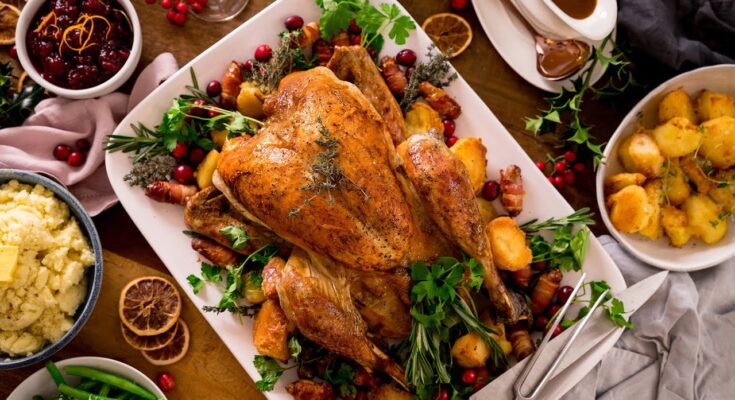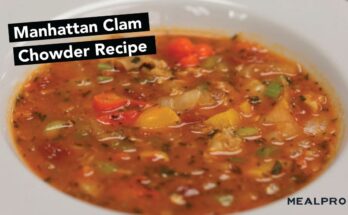Best Turkey Recipe: Cooking a turkey is the centerpiece of many celebrations, especially during holidays like Thanksgiving and Christmas. Whether it’s your first time or you’re a seasoned chef, getting the turkey just right can feel overwhelming. But don’t worry! This guide simplifies the process with step-by-step instructions to help you roast the perfect turkey—moist, flavorful, and golden-brown.
What makes this recipe special? It balances simplicity with rich flavors, ensuring success even if you’re not a pro in the kitchen. Follow along, and let’s create a turkey that will leave your guests asking for seconds!
Ingredients Needed
Essential Ingredients:
- 1 whole turkey (12–16 pounds)
- 1 cup unsalted butter, softened
- 2 tablespoons olive oil
- 4 cloves garlic, minced
- 2 tablespoons fresh rosemary, chopped
- 2 tablespoons fresh thyme, chopped
- 2 tablespoons fresh sage, chopped
- 1 lemon, halved
- 1 onion, quartered
- 2 carrots, chopped
- 2 celery stalks, chopped
- 4 cups chicken broth or turkey stock
- Salt and pepper, to taste
Optional Add-ons for Flavor Enhancement:
- 1 apple, quartered (adds sweetness)
- Fresh parsley for garnish
- Smoked paprika for a hint of spice
- White wine for basting
Tools and Equipment
Must-Have Tools:
- Roasting pan with a rack
- Aluminum foil or parchment paper
- Basting brush or spoon
- Meat thermometer
- Kitchen twine (for tying legs)
Useful Extras:
- Turkey baster for even moisture distribution
- Oven-safe gloves for handling hot trays
- Carving knife and fork for slicing
Step 1: Preparing the Turkey
Thawing the Turkey Safely
- If frozen, thaw the turkey in the refrigerator. Allow 24 hours per 4–5 pounds of turkey.
- Alternatively, use the cold-water method by submerging the turkey in cold water, changing it every 30 minutes until thawed.
Cleaning and Drying Techniques
- Remove the turkey from its packaging and take out the neck and giblets (usually stored inside the cavity).
- Rinse the turkey inside and out with cold water.
- Pat the turkey completely dry with paper towels—this ensures crispy skin during roasting.
Step 2: Seasoning the Turkey
Creating the Perfect Marinade
- In a bowl, mix softened butter, olive oil, minced garlic, chopped herbs, salt, and pepper.
- Massage the mixture under the skin and on top of the turkey. Be sure to get it into all crevices for maximum flavor.
Stuffing Options for Added Flavor
- Fill the cavity with aromatic ingredients like lemon halves, onion quarters, and fresh herbs.
- For added moisture, include apple slices or celery. Avoid overpacking to ensure even cooking.
Step 3: Roasting the Turkey
Setting the Oven Temperature
- Preheat the oven to 325°F (163°C).
Cooking Times Based on Turkey Weight
| Turkey Weight | Unstuffed Cooking Time | Stuffed Cooking Time |
|---|---|---|
| 8–12 pounds | 2 ¾ – 3 hours | 3 – 3 ½ hours |
| 12–14 pounds | 3 – 3 ¾ hours | 3 ½ – 4 hours |
| 14–18 pounds | 3 ¾ – 4 ¼ hours | 4 – 4 ¼ hours |
| 18–20 pounds | 4 ¼ – 4 ½ hours | 4 ¼ – 4 ¾ hours |
- Place the turkey breast-side up on a rack in the roasting pan.
- Add 2 cups of chicken broth to the bottom of the pan to keep the turkey moist.
Step 4: Basting and Monitoring
Importance of Basting for Moisture
- Baste the turkey every 30–45 minutes using pan drippings or melted butter.
- Avoid opening the oven door too often to maintain consistent heat.
How to Check Internal Temperature
- Insert a meat thermometer into the thickest part of the thigh (without touching the bone).
- The internal temperature should read 165°F (74°C) in the breast and 175°F (80°C) in the thigh.
Step 5: Resting and Carving
Letting the Turkey Rest Before Serving
- Cover the turkey loosely with foil and let it rest for 20–30 minutes before carving. This helps retain juices.
Carving Techniques for Professional Presentation
- Remove the legs and thighs first by cutting through the joints.
- Slice the breast meat against the grain for tenderness.
- Arrange slices neatly on a platter and garnish with fresh herbs and lemon wedges.
Gravy and Side Dishes Suggestions
Homemade Gravy Recipe
No turkey feast is complete without a rich, flavorful gravy to drizzle over the meat. Here’s how to make it:
Ingredients:
- Turkey drippings from the roasting pan
- 4 tablespoons unsalted butter
- 4 tablespoons all-purpose flour
- 2 cups chicken or turkey broth
- Salt and pepper to taste
- Optional: Fresh thyme or sage for extra flavor
Instructions:
- Strain the drippings from the roasting pan to remove any solids.
- In a saucepan, melt butter over medium heat, then whisk in the flour to make a roux. Cook for 1–2 minutes until golden brown.
- Gradually add the drippings and broth, whisking constantly to prevent lumps.
- Bring to a simmer and cook until the gravy thickens (about 5–7 minutes).
- Season with salt, pepper, and herbs as desired.
Complementary Side Dishes
- Mashed Potatoes – Creamy and buttery, they pair perfectly with turkey and gravy.
- Roasted Vegetables – Carrots, Brussels sprouts, and sweet potatoes roasted with olive oil and garlic add color and flavor.
- Stuffing – A savory blend of bread cubes, herbs, celery, and onions makes a classic stuffing.
- Cranberry Sauce – Adds a sweet and tangy contrast to the savory turkey.
- Dinner Rolls – Soft and fluffy rolls for soaking up gravy and juices.
Common Mistakes to Avoid
Even experienced cooks can make mistakes when preparing turkey. Here are some common pitfalls and how to avoid them:
- Skipping the Thawing Process: Make sure the turkey is fully thawed before cooking to ensure even roasting.
- Overcooking or Undercooking: Always use a meat thermometer to verify the internal temperature. Don’t rely on cooking times alone.
- Forgetting to Season the Turkey Properly: Be generous with herbs, spices, and butter, including under the skin, for maximum flavor.
- Not Letting the Turkey Rest: Skipping this step can lead to dry meat as the juices won’t have time to redistribute.
- Neglecting to Baste or Add Moisture: Basting regularly or adding broth to the pan prevents the turkey from drying out.
Tips for Making the Turkey Juicy
Brining for Extra Moisture
Soaking the turkey in a saltwater brine before roasting helps lock in moisture and flavor.
Basic Brine Recipe:
- 1 gallon water
- 1 cup salt
- ½ cup sugar
- 4 cloves garlic, crushed
- 1 tablespoon peppercorns
- Fresh herbs like rosemary, thyme, and bay leaves
Instructions:
- Dissolve the salt and sugar in water.
- Add garlic, herbs, and spices.
- Submerge the turkey in the brine for 12–24 hours in the refrigerator.
- Rinse the turkey thoroughly before seasoning and roasting.
Butter and Herb Coating
Rubbing butter mixed with herbs directly under the skin ensures the meat stays moist while adding layers of flavor.
How to Store Leftover Turkey
Safe Storage Tips
- Remove leftover turkey from the bones within 2 hours of cooking.
- Store in airtight containers and refrigerate for up to 4 days or freeze for up to 3 months.
Creative Ways to Use Leftovers
- Turkey Sandwiches: Add cranberry sauce and stuffing for a quick sandwich.
- Turkey Pot Pie: Use leftover turkey in a creamy filling with vegetables and pie crust.
- Turkey Soup: Make a hearty soup with turkey broth, noodles, and vegetables.
- Turkey Salad: Mix with mayo, celery, and grapes for a delicious turkey salad.
- Turkey Tacos: Season and shred turkey for flavorful tacos.
Serving Suggestions
Presentation Tips for Holiday Feasts
- Arrange turkey slices neatly on a large platter, surrounded by roasted vegetables.
- Garnish with fresh herbs like rosemary and thyme.
- Add lemon slices or cranberries for a festive touch.
Beverage Pairing Ideas
- White Wine: Chardonnay or Sauvignon Blanc complements turkey’s mild flavor.
- Red Wine: Pinot Noir offers a light, fruity balance.
- Non-Alcoholic Options: Sparkling apple cider or cranberry juice for a refreshing taste.
Nutritional Information
| Nutrient | Amount per Serving (3 oz) |
|---|---|
| Calories | 135 |
| Protein | 25 g |
| Fat | 3 g |
| Saturated Fat | 1 g |
| Cholesterol | 70 mg |
| Sodium | 60 mg |
Healthier Variations
- Use olive oil instead of butter for a lighter option.
- Opt for lean breast meat and skip the skin to reduce fat intake.
- Roast with plenty of vegetables for added fiber and nutrients.
FAQs about the Best Turkey Recipe
What is the best temperature to cook a turkey?
The ideal cooking temperature for a turkey is 325°F (165°C). This temperature ensures the turkey cooks evenly, preventing the outer layers from drying out before the inside is done.
How long should I cook a turkey?
The general rule is to cook the turkey for about 13 minutes per pound. However, the best indicator is the internal temperature, which should reach 165°F (74°C) in the thickest part of the thigh.
Should I brine my turkey before cooking?
Brining a turkey can help lock in moisture and flavor. A simple brine solution includes water, salt, sugar, and a variety of spices and herbs. Brining for 12 to 24 hours before cooking is recommended for the best results.
What are some tips for making the turkey skin crispy?
To achieve crispy skin, pat the turkey dry before cooking and rub the skin with oil or butter. Consider starting the oven at a higher temperature (around 400°F or 204°C) for the first 30 minutes, then lower it to 325°F (165°C) for the remaining cooking time.
Can I stuff my turkey? What should I use?
You can stuff a turkey, but it’s important to cook the stuffing to 165°F (74°C) to ensure it’s safe to eat. Popular stuffing ingredients include breadcrumbs, herbs, onions, and celery. For safety and even cooking, consider cooking the stuffing separately.
How do I keep my turkey moist?
To keep your turkey moist, avoid overcooking and use a basting technique. Basting involves spooning the pan juices over the turkey periodically during cooking. Alternatively, covering the breast with aluminum foil during cooking can help prevent excessive drying.
What should I do with leftover turkey?
Leftover turkey can be stored in the refrigerator for up to four days or frozen for longer storage. Use leftover turkey in sandwiches, soups, salads, or casseroles for delicious meals after your feast.
Final Thoughts
This step-by-step turkey recipe ensures a flavorful, juicy, and perfectly roasted bird every time. Whether it’s a holiday gathering or a family feast, this recipe is designed to impress your guests while making your cooking process stress-free. Feel free to experiment with spices, stuffings, and sides to create a meal that reflects your personal touch.
With this guide, you’re now ready to master the art of cooking turkey and make any occasion truly special.



